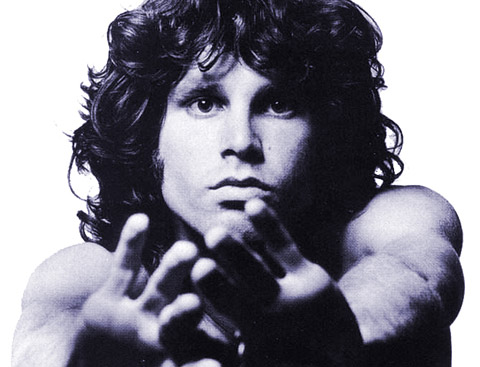
THE LIZARD KING Jim Morrison was perhaps the single greatest influence on goth. |
Popular music — whatever its occasional sadness — is typically viewed as a cheery commodity, meant to get toes tapping in the face of the drudgery and senselessness of modern life. But beneath pop's facade lurks a dark undergrowth, always present and forever providing its own counterpoint — a bleakness that makes your feet move even as it subsumes you in gloom. Darkness in music is of course nothing new, from the so-called Devil's tritone of the Middle Ages to the blues and torch songs of the 20th century. But when melancholy began being mingled with anachronistic notions of doomed romanticism in a post–World War setting, the modern conceit of the goth was born. Whether it's the stabbing strains of Carl Orff's 1932 cantata Carmina Burana or the truncheons-to-the-winds tritone avalanche of Black Sabbath's "Black Sabbath," the merging of a dramatic attack and a preoccupation with death has been as effective a force in modern music as the sunnier route.Goth rock solidified in the early '80s but was in truth a few decades older: as late-'60s youth culture curdled into '70s cynicism, those who had poked at hippie optimism began to seem prophets, which sort of explains how Jim Morrison and his low-effort erotic croon wound up being perhaps the greatest influence on goth. And it isn't just the Lizard King's deep voice and propensity for black leather — goth is a romantic movement, and Chief Mojo Risin's poetic nods to Rimbaud, et al., spoke to an inconsolably jaded youth movement.
Morrison's 1971 death only solidified his undead legend to a crew of subsequent goth precursors, whether in the slithering nihilism of Iggy Pop, the makeup-laden theatrics of stadium-filling genius-provocateur Alice Cooper, or the sick fantasies of gravedigger-turned-punk-frontman Dave Vanian, who was perhaps the first to combine corpse makeup with punk rock in the Damned.
In a sense, the '70s were a gothic time, begun with the stabbing madness of Manson (Charlie, not Marilyn) and ending roughly with Jonestown, as summonings to death and madness flourished on the news and in the air. Even popular music wasn't immune, whether it was the suicide paean that was Blue Oyster Cult's chart-topping "Don't Fear the Reaper" or "Hotel California," the Eagles' bazillion-selling ode to the inevitability of giving yourself over to Satan. You can check out any time you like but you can never leave, so you might as well drink the Kool-Aid and paint your nails black, right? "Goth" was, it's important to note, initially known as "death rock," and that strain of dramatic dirge mania continued to have an impact on mainstream music even while goth as a punk offshoot became a legitimate cult of the disenfranchised.
You may not have heard Bauhaus or Siouxsie on AM radio in the '80s — but you did hear Bonnie Tyler's plainly gothic ür-torchsong "Total Eclipse of the Heart," as well as Prince's mesmerizing "When Doves Cry," mixing hyperfunk with the assymetrical hairdo, painted fingernails, frilly shirts, and teardrop fetishism of goth's Edwardian contingent.